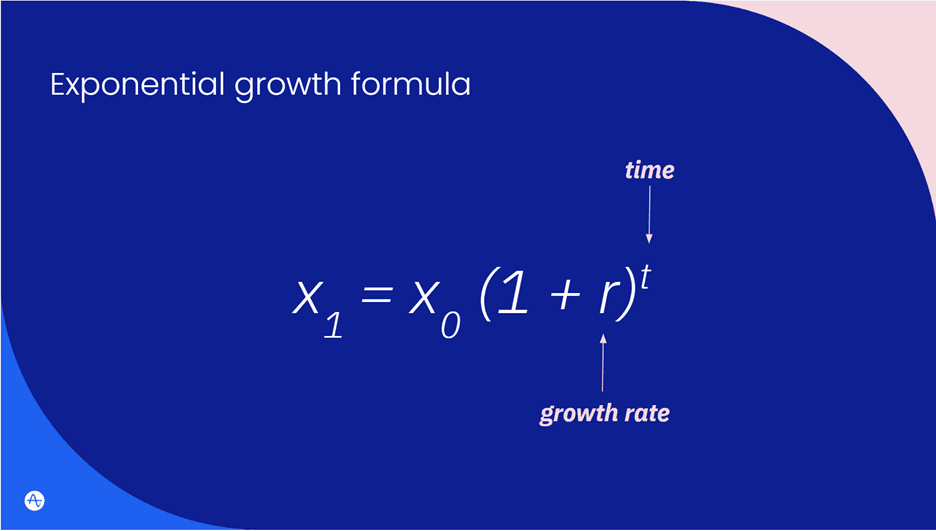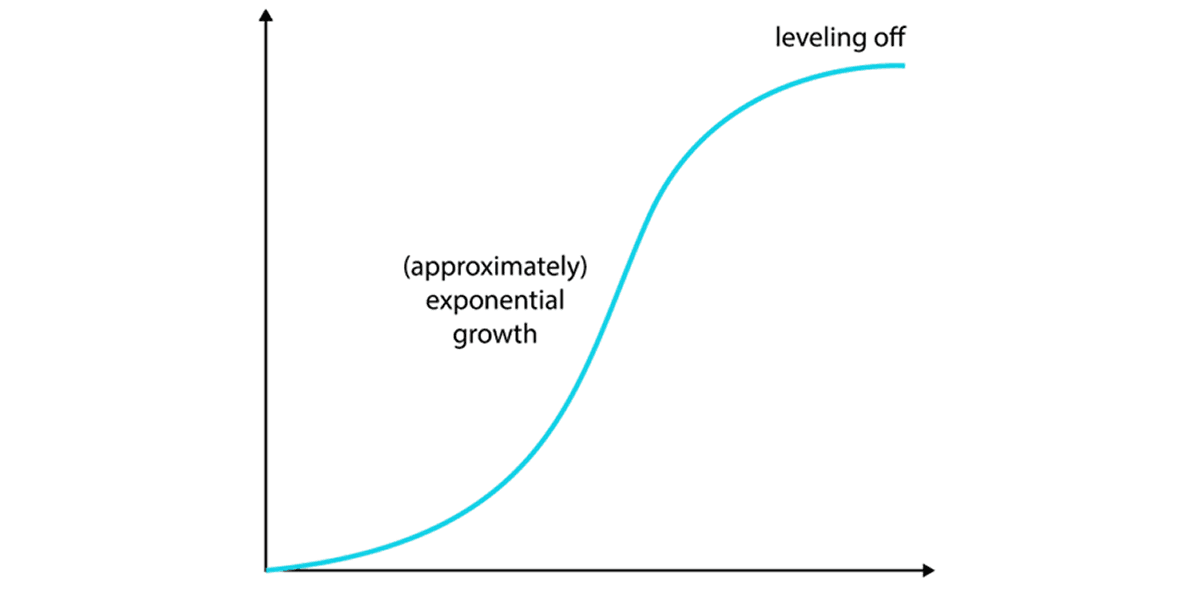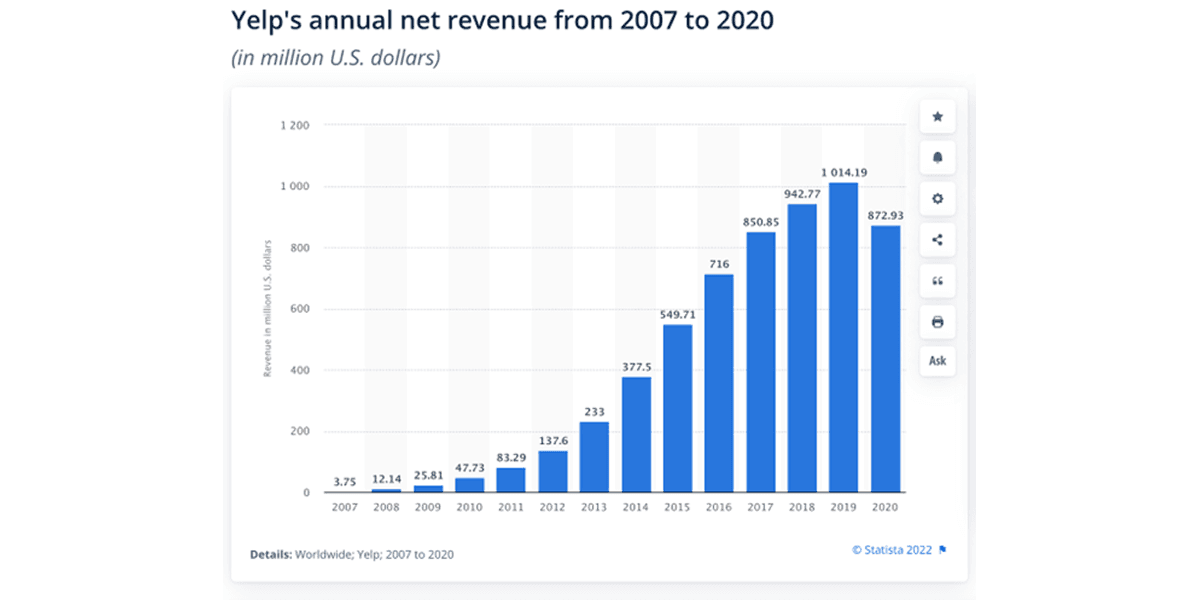What Exponential Growth Really Looks Like (And How to Hit It)
Learn what exponential growth is, how to calculate it, and how to put in place strategies that will help you achieve it.
Originally published on November 24, 2023.
Table of Contents
What does it mean for growth to be exponential? Consider Facebook.
Starting with nearly 1 million users in 2004, it reached over a billion users by 2015. And that growth continued, generating revenue to fuel Facebook's expansion, acquisition of other social platforms, and the ultimate consolidation of apps and technologies under one brand, Meta. In the first quarter of 2023, Meta reported 3.81 billion people using at least one of the company's core products.
Exponential growth means that year over year, your customer base isn't going up in a straight line—it's going up like a hockey stick. And the bigger you get, the faster you grow.
So, what makes Facebook and other companies who have experienced exponential growth able to do that successfully? Let's uncover the mechanics behind exponential growth and the steps to harness it for your team.
Key Takeaways
- Exponential growth is when the amount added to a quantity (like a user base) is proportional to the amount already present instead of a fixed amount.
- The formula for exponential growth is x₁ = x₀(1+r)ᵗ
- Exponential business growth starts with a product-market fit, but it can be accelerated with referrals, social sharing, push notifications, and a scalable business model.
- Exponential growth can't last forever, so businesses should set reasonable long-term expectations.
How exponential growth works
Exponential growth works by compounding, which means the amount added is proportional to the amount already present. Unlike linear growth, where you add a fixed amount of users each period, with exponential growth you're multiplying the previous amount. The bigger the current size, the greater the increase—so growth constantly accelerates over time.
For a business, this could mean:
- A user base that doubles monthly from 1,000 to 2,000 to 4,000 to 8,000.
- Revenue that compounds yearly from $10K to $30K to $90K.
- Social virality where over the course of a week, a post gets 20 views, then 200, then 2,000, then 20,000.
You can model exponential growth as a mathematical formula for variable x growing at a rate r over a time interval t (days, months, years, etc.). In the equation below, x₀ is the starting value, and x₁ is what it's grown to in the future.

The equation may look complicated, but it’s just saying that your current growth rate is proportional to your current size. If you've ever had to calculate compound interest, this works the same way.
Let's try it out for customer growth. Say at the start of a year, we have 2 customers (x₀ = 2), and our monthly growth rate r is 1 (or a rate of 100%, meaning our current value doubles every month). Plugging those numbers into the equation, the next six months would look like this:
|
Month |
Jan 23 |
Feb 23 |
Mar 23 |
Apr 23 |
May 23 |
Jun 23 |
|
t = |
0 |
1 |
2 |
3 |
4 |
5 |
|
Customers |
2 |
4 |
8 |
16 |
32 |
64 |
64 customers after six months of hard work doesn't sound like exponential growth—but what happens as it continues over time? Let's keep going through 2023 and into 2024:
| Month | Jul 23 | Aug 23 | Sep 23 | Oct 23 | Nov 23 | Dec 23 |
| t = | 6 | 7 | 8 | 9 | 10 | 11 |
| Customers | 128 | 256 | 512 | 1,024 | 2,048 | 4,096 |
| Month | Jan 24 | Feb 24 | Mar 24 | Apr 24 | May 24 | Jun 24 |
| t = | 12 | 13 | 14 | 15 | 16 | 17 |
| Customers | 8,192 | 16,384 | 32,768 | 65,536 | 131,072 | 262,144 |
At that same growth rate of 100%, you've hit over a quarter of a million customers in a year and a half. Two months later, you'll be over a million. And if you continued the formula through June 2025, you'd have over 1 billion users.
How to hit exponential growth
So how do you actually grow exponentially? That's the million (or billion, depending on your growth rate) dollar question that entrepreneurs and product managers try to answer. There's no surefire path to exponential growth, but there are strategies that can help.
At the most basic level, achieving exponential growth starts with strong product-market fit, which is then amplified through viral mechanics and network effects.
The process works like this:
- Foundation: Users enjoy your product enough to recommend it.
- Viral loop: Each recommending user brings in multiple new users.
- Network effects: More users make the product more valuable for everyone, adding more enjoyment.
- Acceleration: Growth increases as the user base expands.
To put those basics into practice, it helps to also focus on these five key techniques:
Build a great product
Exponential growth is only possible if people love to use your product. They must form a habit of repeatedly using your product to retain them for long-term growth. You don’t want users to abandon your product because it’s too complicated, as that would eliminate the probability of exponential growth.
To understand your product’s ease of use, leverage the “grandma test.” Ask yourself, “Would I refer this product to my grandma?” to help you gauge its simplicity.
You should adopt an obsessive mindset about building something users love and view the product strategy process as a perpetual work in progress.
Incentivize referrals
Incentivizing product referrals encourages customers to recommend your product, in turn growing your customer base and transforming customers into loyal brand advocates.
Dropbox grew exponentially by 3,900% in just 15 months by incentivizing referrals and building a viral loop into their referral program. They gave an additional 500 MB of space to the referrer and the referee for each successful referral, up to a limit of 16GB.
They also realized that the more people knew about their referral program, the more they would participate. So, apart from offering a meaningful incentive, they also integrated their referral program into their onboarding process to make it more visible.
Dropbox made it easy for users to complete referrals, providing options like sharing a unique referral link or syncing their contacts from their email account. It also gave users more transparency into the referral process with a referral status dashboard.
Every successful referral also triggered a “thank you” email to both the referrer and the referee—with a call to action incentivizing both to invite more friends. Dropbox’s systematic, well-organized approach to its referral program helped it grow from 100k users in September 2008 to 4 million users in September 2017.
Use social sharing
Sharing information about products on social media acts as an organic product recommendation. People typically trust organic recommendations over incentivized ones, which can lead to higher product adoption and an increased chance of exponential growth.
For example, you’ve likely seen your fair share of sweaty post-workout pictures on social media. That’s because many fitness apps encourage users to share their workout metrics via social media to create a sense of achievement and attract praise and engagement with their friends.
Workout posts are a great example of how a product or app can spread the word organically using social sharing. Users are not pressured to share these stats—it’s all done voluntarily by them. The organic nature of social sharing helps attract new users and new growth.
Provide relevant, valuable information
28% of users uninstall apps because they receive too many ads and notifications. That’s why it’s critical that push notifications and ads are timely, relevant, and valuable to avoid irritating customers.
For instance, Uber notifies its drivers of high-demand areas through push notifications so they can offer rides there to make more money. Providing relevant information helps engage users and increase the likelihood they’ll continue using your product long-term, leading to exponential growth through retention.
Have a scalable business model
You should adopt a business model or technology stack that allows you to scale efficiently. For example, exponential customer demand for a restaurant could lead to them turning potential customers away. A restaurant can only serve a certain number of customers at any given time, so exponential growth is likely not feasible in this context.
However, exponential growth would be possible for an online travel site that connects hosts with guests for temporary accommodation. Once the platform is built, it could grow by adding new hosts and guests, making it a scalable business model.
Exponential growth can’t last forever
No business can grow exponentially forever—or usually, even for very long. Eventually, factors change, the growth rate levels off, and the hockey stick becomes an s curve.

Common limiting factors include:
- Market saturation: You reach most potential customers.
- Resource constraints: Funding, talent, or infrastructure bottlenecks.
- Competition: Others copy successful strategies.
- Operational complexity: Systems break down at scale.
- Economic cycles: Market conditions and demand change.
For instance, while Yelp's revenue grew from $3.75 million in 2007 to over $1 billion in 2019, 2020 saw a drop in revenue to $872.9 million. The coronavirus pandemic severely impacted Yelp's exponential growth curve since it mainly focuses on local businesses that require the physical presence of customers to succeed. With lockdowns and social distancing rules, these businesses couldn't function normally for a long time.
Additionally, Yelp's growth relied on user-generated content and the peculiar power of Google backlinks. However, Google has adjusted its algorithm to prevent backlink quantity from producing exponential returns, so this approach would no longer work.
This example demonstrates that you should adapt your path toward hitting exponential growth depending on the tools, tactics, and strategies available. Plan for this transition by building sustainable growth models before exponential growth slows.
Better understand your customer growth with Amplitude
Delivering exponential growth takes clear insight into user behavior and product performance.
Amplitude helps you achieve exponential growth by:
- Tracking leading indicators: Identify early signals of viral potential.
- Measuring viral coefficients: See how many users each customer brings.
- Analyzing retention patterns: Understand what keeps users coming back.
- Optimizing conversion funnels: Remove friction that prevents growth.
Ready to turn exponential growth theory into practice? Try Amplitude for free today and start identifying your growth opportunities.

Julia Sholtz
Former Group Product Marketing Manager, Amplitude
Julia is a former product marketer at Amplitude. She focuses on go-to-market solutions for enterprise customers.
More from Julia





